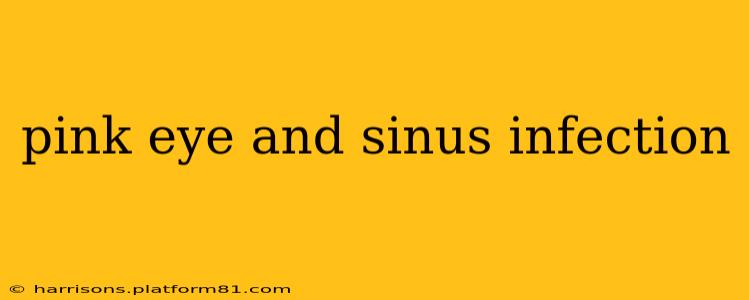Pink eye, or conjunctivitis, and sinus infections are both common ailments, but they can sometimes occur together or even influence each other. While not directly related in a causative way, the proximity of the affected areas (eyes and sinuses) means symptoms can overlap and treatment approaches need to consider both conditions. This comprehensive guide will explore the relationship between pink eye and sinus infections, clarifying symptoms, causes, and effective treatment strategies.
What is Pink Eye (Conjunctivitis)?
Pink eye is an inflammation or infection of the conjunctiva, the membrane lining the inside of your eyelids and covering the white part of your eye. It's characterized by redness, itchiness, and often a discharge. Several things can cause pink eye, including:
- Viral infections: This is the most common cause, often accompanied by other cold or flu symptoms.
- Bacterial infections: Bacterial conjunctivitis is often treated with antibiotic eye drops.
- Allergic conjunctivitis: Triggered by allergens like pollen, dust mites, or pet dander. This type usually doesn't involve a discharge.
- Irritants: Chemicals, smoke, or other irritants can also cause inflammation.
Symptoms of Pink Eye: These can vary depending on the cause but often include:
- Redness of the eye(s)
- Itching
- Burning or stinging sensation
- Watery or thick discharge (pus-like in bacterial infections)
- Crusting of the eyelids, especially upon waking
- Sensitivity to light (photophobia)
- Blurred vision (usually temporary)
What is a Sinus Infection (Sinusitis)?
A sinus infection, or sinusitis, involves inflammation of the sinuses—air-filled spaces in your skull around your nose, forehead, and cheeks. Sinusitis can be acute (short-term) or chronic (long-term). Common causes include:
- Viral infections: Often following a common cold.
- Bacterial infections: A bacterial infection can develop after a viral infection.
- Fungal infections: Less common but can be severe.
- Allergies: Inflammation from allergies can make the sinuses more susceptible to infection.
Symptoms of a Sinus Infection: These can vary in severity and duration:
- Facial pain or pressure, often worst in the morning
- Congestion
- Runny or stuffy nose
- Postnasal drip
- Cough
- Fever
- Fatigue
- Reduced sense of smell
Can a Sinus Infection Cause Pink Eye?
While a sinus infection doesn't directly cause pink eye, the close proximity of the sinuses and eyes means that drainage from infected sinuses can irritate the eyes, leading to symptoms similar to pink eye. The irritation from postnasal drip, for example, can cause redness, itchiness, and a watery discharge, mimicking some symptoms of conjunctivitis. However, this is irritation rather than a true infection of the conjunctiva.
Can Pink Eye Cause a Sinus Infection?
Similarly, pink eye doesn't directly cause a sinus infection. However, if the pink eye is caused by a virus or bacteria, it's possible that the same pathogen could spread to the sinuses, increasing the risk of developing sinusitis. This is more likely if the pink eye involves a significant discharge that could come into contact with the nasal passages.
How are Pink Eye and Sinus Infections Treated?
Treatment depends on the underlying cause of each condition:
- Viral pink eye and sinusitis: Treatment is largely supportive, focusing on managing symptoms with rest, fluids, and over-the-counter pain relievers.
- Bacterial pink eye: Antibiotic eye drops are typically prescribed.
- Bacterial sinusitis: Antibiotics may be prescribed, but this is often based on the severity and duration of symptoms.
- Allergic pink eye and sinusitis: Antihistamines and decongestants can help manage symptoms.
When Should I See a Doctor?
You should seek medical attention if:
- Symptoms are severe or worsen.
- You have vision changes.
- You have a fever.
- You have significant pain or pressure in your face.
- Symptoms persist for more than a week.
What are the differences between viral, bacterial, and allergic conjunctivitis?
Viral conjunctivitis is highly contagious and often accompanied by other cold symptoms. Bacterial conjunctivitis involves a thicker, pus-like discharge and may respond to antibiotics. Allergic conjunctivitis is usually itchy but lacks a significant discharge and is linked to allergens.
How long does it take for pink eye to go away?
The duration of pink eye varies depending on the cause. Viral conjunctivitis usually resolves within a week or two, while bacterial conjunctivitis often improves within a few days with antibiotic treatment. Allergic conjunctivitis may persist as long as exposure to the allergen continues.
How can I prevent pink eye and sinus infections?
Good hygiene practices, such as frequent handwashing, can help prevent the spread of both conditions. Avoiding close contact with those who are sick and avoiding touching your eyes can also reduce the risk. Treating allergies effectively can also help prevent related infections.
This information is intended for general knowledge and informational purposes only, and does not constitute medical advice. Always consult with a qualified healthcare professional for diagnosis and treatment of any medical condition.
